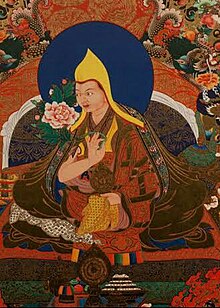| 1st Dalai Lama, Gedun Drupa | |
|---|---|
| ཏཱ་ལའི་བླ་མ་སྐུ་ཕྲེང་དང་པོ།, ཀེ་ཏུན་ཏེ་ལུའུ་པ། | |
 དགེ་འདུན་གྲུབ་པ། དགེ་འདུན་གྲུབ་པ། | |
| Title | 1st Dalai Lama (posthumous designation) |
| Personal life | |
| Born | Péma Dorjee 1391 Shabtod, Ü-Tsang, Tibet |
| Died | 1474 (aged 82–83) Ü-Tsang, Tibet |
| Parents |
|
| Religious life | |
| Religion | Tibetan Buddhism |
| Senior posting | |
| Successor | Gedun Gyatso |
| Original name: Péma Dorjee | |||||||
|---|---|---|---|---|---|---|---|
| Chinese name | |||||||
| Chinese | 巴玛多杰 | ||||||
| |||||||
| Tibetan name | |||||||
| Tibetan | པད་མ་རྡོ་རྗེ་ | ||||||
| |||||||
The 1st Dalai Lama, Gedun Drupa (Tibetan: དགེ་འདུན་གྲུབ་པ།, Wylie: dge 'dun grub pa; 1391–1474) was a student of Je Tsongkhapa, and became his first Khenpo (Abbott) at Ganden Monastery. He also founded Tashi Lhunpo Monastery in Shigaste. He was posthumously awarded the spiritual title of Dalai Lama.
Biography

Gedun Drupa was born in a cow-shed in Gyurmey Rupa near Sakya in the Tsang region of central Tibet, the son of Gonpo Dorjee and Jomo Namkha Kyi, nomadic tribespeople. He was raised as a shepherd until the age of seven. His birth name (according to the Tibetan Buddhist Resource Center, his personal name) was Péma Dorjee (Tibetan: པད་མ་རྡོ་རྗེ་, "Vajra Lotus").
Ordination
Later he was placed in Narthang Monastery. In 1405, he took his getsul (novitiate) vows from the abbot of Narthang, Khenchen Drupa Sherap. When he was 20 years old, in about 1411 received the name Gedun Drupa upon taking the vows of a bhikṣu (monk) from the abbot of Narthang Monastery. Also at this age he became a student of the scholar and reformer Je Tsongkhapa (1357–1419), who some say was his uncle. Around this time he also became the first abbot of Ganden Monastery, founded by Tsongkhapa himself in 1409.
Career
By the middle of his life, Gedun Drupa had become one of the most esteemed scholar-saints in the country. Gedun Drupa founded the major monastery of Tashi Lhunpo Monastery at Shigatse, which later became the seat of the Panchen Lamas.
Gedun Drupa did not hold national political power. It was in the hands of viceroys such as the Sakyas, the prince of Tsang, and the Mongolian Khagan. The Tibetan national political leadership positions of the successive Dalai Lamas began much later during the reign of the 5th Dalai Lama, in 1642.
He remained the Khenpo of Tashi Lhunpo Monastery until he died while meditating in 1474 at the age of 84 (83 by Western reckoning).
Legends
Tradition states that Palden Lhamo, the female guardian spirit of the sacred lake, Lhamo La-tso, promised the First Dalai Lama in one of her visions "...that she would protect the reincarnation lineage of the Dalai Lamas." Since the time of Gedun Gyatso, who formalized the system, monks have gone to the lake to meditate when seeking visions with guidance on finding the next reincarnation.
Notable contemporaries
The Samding Dorje Phagmo (1422–1455), the highest female incarnation in Tibet, was a contemporary of Gedun Drupa. Her teacher, the Bodongpa Panchen Chogley Namgyal was also one of his teachers; he received many teachings and empowerments from him.
Works
Some of the most famous texts Gedun Drupa wrote were:
- Sunlight on the Path to Freedom, a commentary on Abhidharma-kosa
- Crushing the Forces of Evil to Dust, an epic poem on the life and liberating deeds of Gautama Buddha
- Song of the Eastern Snow Mountain, a poem dedicated to Je Tsongkhapa
- Praise of the Venerable Lady Khadiravani Tara, an homage to Tara
References
- "Short Biographies of the Previous Dalai Lamas". DalaiLama.com. Retrieved May 13, 2018.
- "dge 'dun grub pa". Tibetan Buddhist Resource Center. Retrieved May 20, 2015.
- Gedun Drupa Archived December 13, 2005, at the Wayback Machine at Dalai Lama website.
- Samphel & Tendar (2004), p. 75.
- Farrer-Halls (1998), p. 77.
- ^ Samphel & Tendar (2004), p. 35.
- Simhanada, The Lion's Roar of Mahayana Buddhism, archived from the original on July 11, 2016
- Chö Yang: The Voice of Tibetan Religion and Culture (Year of Tibet ed.). Gangchen Kyishong, Dharamshala: Council for Religious and Cultural Affairs. 1991. p. 79.
- Laird (2006), pp. 139, 264–265.
- Dowman (1988), p. 268.
- "Bodong.info". Archived from the original on August 28, 2008. Retrieved March 7, 2009.
Works cited
- Dowman, Keith (1988). The Power-places of Central Tibet: The Pilgrim's Guide. Routledge & Kegan Paul. ISBN 0-7102-1370-0.
- Farrer-Halls, Gill (1998). World of the Dalai Lama. Quest Books. p. 77.
- Laird, Thomas (2006). The Story of Tibet: Conversations with the Dalai Lama. N.Y.: Grove Press. ISBN 978-0-8021-1827-1.
- Samphel, Thubten; Tendar (2004). The Dalai Lamas of Tibet. New Delhi: Roli & Janssen. ISBN 81-7436-085-9.
Further reading
- McKay, A. (editor) (2003): History of Tibet. Publisher: RoutledgeCurzon. ISBN 0-7007-1508-8
- Mullin, Glenn H. (2001). The Fourteen Dalai Lamas: A Sacred Legacy of Reincarnation, pp. 50–85. Clear Light Publishers. Santa Fe, New Mexico. ISBN 1-57416-092-3.
- Dalai Elan Roebuck. (1991) Freedom in Exile: The Autobiography of the Dalai Lama. San Francisco, CA.
- Selected Works of the Dalai Lama I by Anne Kandt, Christine Cox, Dalai Lama Dge-Dun-Grub I, Glenn H. Mullin, Sidney Piburn (1985)
External links
| Buddhist titles | ||
|---|---|---|
| Preceded byNew creation | Dalai Lama N/A Posthumously recognized |
Succeeded byGedun Gyatso |
| Dalai Lamas | |||
|---|---|---|---|
